ATI TEAS PRACTICE TEST Science 2022 with complete solutions
Document Content and Description Below
The first four steps on the scientific method are as follows: I. Identify the problem. II. Ask questions. III. Develop a hypothesis. Iv. Collect data and experiment on that data. Which of t... he following is the fifth step in the scientific method? A. Observe the data. B. Analyze the results. C. Measure the data. D. Develop a conclusion. - ANSWER B. Analyze the results. - There are six steps in the scientific process. The results of step four must be analyzed before reaching the final step. "Develop a conclusion." Which of the following is FALSE regarding the use of qualitative and quantitative data in scientific research? A. Quantitative data is collected through numerical measurements. B. Quantitative data is more accurate than qualitative data. C. Qualitative data is focused on perspectives and behavior. D. Qualitative data is collected through observation and interviews. - ANSWER B. Quantitative data is more accurate than qualitative data. The two types of measurement important in science are qualitative (When a numerical result is used) and qualitative (when descriptions or qualities are reported). - Qualitative data is collected through observation and interviews, and focuses on the informant's behavior and perspectives. THE NEXT QUESTION REFERS TO THE FOLLOWING GRAPHICS: The chart above shows the average snowfall in inches for a two on Michigan's Upper Peninsula, during the months November through April. Which of the following can be concluded based on the information that is provided in the chart? A. April is not a good month to go skiing in the Upper Peninsula. B. Snowfall blocks the sunshine reduces the number of sunny days. C. The fewest sunny days occur in the months with the heaviest snowfall. D. There is no connection between the amount of snowfall and the number of sunny days. - ANSWER C. The chart shows two specific changes: snowfall levels from November to April and sunny days from November to April. Which of the following statements correctly describes the function of the corresponding physiologic structure? A. The trachea connects the throat and the stomach, encouraging food to follow this path through contractions. B. The esophagus is the cylindrical portion of the respiratory tract that joins the larynx with the lungs. C. the diaphragm is a muscle that controls the height of the thoracic cavity, decreasing the height on contraction, and increasing the height on relaxation causing expiration. D. The epiglottis covers the trachea during swallowing, preventing food from entering the airway. - ANSWER D. The epiglottis covers the trachea during swelling, thus preventing food from entering the airway. - The trachea (windpipe) is cylindrical portion of the reparatory tract that joins the larynx with the lungs. - The esophagus connects the throat and the stomach. When a person swallows, the esophagus contracts to force the food down into the stomach. The esophagus secretes mucus for lubrication. - The diaphragm is a muscle that controls the height of the thoracic cavity, increasing the height on contraction (inspiration), and decreasing the height on relaxation (expiration). Which of the following is an example of the location and function of cartilage int he body? A. The dense connective tissue that comprises the better part of the structural skeleton. B. The supportive pads that provide cushion at joints, such as between the vertebrae of the spinal cord. C. The connective structure made of fibrous collagen that connects muscles and bones, such as the connection of the patella to the quadricep. D. The layer beneath the skin and on the outside of internal organs that provides cushioning and protection. - ANSWER B. The pads that support the vertebrae are made up of cartilage. - Cartilage, a strong form of connective tissue, cushions ad supports the joints. Cartilage also makes up the larynx and the outer ear. - Bone is a form of connective tissue that comprises the better part of the skeleton. It includes both organic and inorganic substances. - Tendons connect the muscles to other structures of the body, typically bones. Tendons can increase and decrease in length as the bones move. - Fat is a combination of lipids; in humans, fat forms a layer beneath the skin and on the outside of the internal organs. Two criteria for classifying epithelial tissue are: A. Cell type and cell function B. Cell shape and cell type C. Cell layers and cell shape D. Cell function and cell layers - ANSWER C. Cell layers and cell shape are the criteria for classifying epithelial tissue. - Cell layers refers to the amount of cells that separate the basement membrane from the surface, such as a simple single layer, a stratified layer (2 or more), or a pseudostratfied layer. - Cell shapes refer to the shape of the outer cells and can be squamous, columnar or cuboidal. Where is the parathyroid gland located? A. On the lateral lobes of the thyroid gland, on the posterior aspect. B. On the pyramidal lobe of the thyroid gland, on the posterior aspect. C. On the lateral thyroid gland, on the anterior aspect. D. On the left lateral lobe of the thyroid gland, on the anterior aspect. - ANSWER A. The parathyroid gland is located on the lateral lobes of the thyroid gland in the neck, on the posterior aspect. - It is part of the endocrine system. - When the supply of calcium in blood diminishes to unhealthy levels, the parathyroid gland motivates the secretion of a hormone that encourages the bones to release calcium into the bloodstream. The parathyroid Gand also regulates the amount of phosphate in the blood by stimulating the excretion of phosphates in the urine. How many organ system are in the human body? A. 12 B. 15 C. 9 D. 11 - ANSWER D. There are 11 organ systems n the human body. - Circulatory System - Digestive System - Endocrine System - Integumentary System - Lymphatic System - Muscular System - Nervous System - Reproductive System - Respiratory System - Skeletal System - Urinary System Which element or structure within the respiratory system is responsible for removing foreign matter from the lungs? A. Bronchial tubes B. Cilia C. Trachea D. Alveoli - ANSWER B. Cilia. - The cilia are the tiny hairs in the respiratory system that are responsible for removing reign matter from the lungs. - The cilia are located within the bronchial tubes, but it is the cilia that have the responsibility for removing inappropriate materials before they enter the lungs. Organized from highest to lowest, what is the hierarchy of the human body's structures is as follows: - Organism, organ systems, organs, tissues. Which of the following comes next? A. Organs, cells, tissues, molecules, atoms B. Organ system, organism, organ, cells, tissues, atoms, molecules C. Organism, organ system, organs, tissues, cells, molecules, atoms D. Organism, organ, cells, tissues, molecules, atoms - ANSWER C. The order of hierarchy of human body structures is as follows: - Organism - Organ systems - Organs - Tissues - Cells - Molecules - Atoms Muscles are types of tissues, so muscles do not have a separate place in the hierarchy but instead fall within the types of tissues. THE NEXT TWO QUESTIONS ARE BASED ON THE PERIODIC TABLE On average, how many neutrons does one atom of bromine(Br) have? Atomic # - 35 Atomic mass - 79.9 A. 35 B. 44.90 C. 45 D. 79.90 - ANSWER B. 44.90 79.9-35 = 44.90 On average, how many protons does one atom of zinc (Zn) have? Atomic # - 30 Atomic mass - 65.39 A. 30 B. 35 C. 35.99 D. 65.39 - ANSWER A. 30 The number of protons is the same for every atom of a given element and is the elements's atomic number; in this case 30 for Zinc (Zn). Which statement below correctly describes the movement of molecules in the body and/or in relation to the external environment? A. Osmosis is the movement of a solution from and area of low solute concentration to an area of high solute concentration. B. Diffusion is the process in the lungs by which oxygen is transported from the air to the blood. C. Dissipation is the transport of molecules across a semipermeable membrane from an area of low concentration to high concentration, requiring energy. D. Reverse osmosis is the movement of molecules in a solution from an area of high concentration to an area of lower concentration. - ANSWER B. In the lungs, oxygen is transported from the air to the blood through the process of diffusion. In which molecules passively move from an area of high concentration to low concentration. Specifically, the alveolar membranes withdraw the oxygen form the air in the lungs into the bloodstream. - Osmosis is the passive movement of a water from an area of low solute concentration to an area of higher solute concentration through a permeable membrane. - Reverse osmosis is the active transport of water opposite the concentration gradient from an area of low solute concentration to high solute concentration. - Dissipation is a more general reference of the spread or loss of energy. Which gland is responsible for the regulation of calcium levels? A. the parathyroid glands B. the pituitary gland C. the adrenal glands D. the pancreas - ANSWER A. The parathyroid glands The parathyroid glands are four small glands that isa on top of the thyroid gland and regulate calcium levels by secreting parathyroid hormone. The hormone regulates the amount of calcium and magnesium that is excreted by the kidneys into the urine. Which statement matches the function to the organ of the digestive system? A. The large intestine reabsorbs water int he body to form solid waste. B The duodenum is the middle section of the small intestine in which acids, fat, and sugar are absorbed. C. The jejunum is the first part of the small intestine that receives chyme form the stomach and further digests it prior to entering the large intestine. D. The gallbladder produces insulin to assist in the transport of sugars form the blood to the organs. - ANSWER A. The large intestine's main function is the reaborsptlon of water into the body to form solid waste. It also allows for the absorption of vitamin K produced by microbes living inside the large intestine. - The duodenum is the first second of the small intestine that receives partially digested food from the stomach, also called chyme, further digestion tit with the help of enzymes released by the gall bladder, before it enters into the small intestine. - The pancreases (not the gall bladder) releases insulin to assist in the removal and transport of sugar in the body. - The jejunum is the second portion of the small intestine in which amino acids, fatty acids, and sugars are absorbed. In your garden, you noticed that the tomato plants did better on the north side of your house than the west side and you decided to figure out why. They are both planted with the same soil that provides adequate nutrients to the plant, and they are watered at the same time during the week. Over the course of a week, you begin to measure the amount of sunlight that hits each side of the house and determine that the north side gets more light because the sunlight is blocked by the house's shadow on the west side. What is the name of the factor in your observations that affected the tomato plants growth? A. the control B. the independent variable C. the dependent variable D. The conclusion - ANSWER B. The conclusion was that the amount of sunlight received by the pants was affecting their growth. - The independent variable was the amount of light that was given to the plants and could have been manipulated by the experiment by moving the plants or adding equal parts of light. - No control was used in this experiment. Which of the following describes one responsibility of the integumentary system? A. Distributing vital substances (such as nutrients) throughout the body B. Blocking pathogens that cause disease C. Sending leaked fluids from cardiovascular system back to the blood vessels D. sorting bodily hormones that influence gender traits. - ANSWER B. The integumentary system includes skin, hair, and mucous membranes, all of which are responsible-in part, at least-for blocking disease-causing pathogens from entering the bloodstream. - The circulatory system distributes vital substances through the body. - The lymphatic system sends leaked fluids from the cardiovascular system back to the blood vessels. - The reproductive system stores bodily hormones that influence gender traits. When are the parasympathetic nerves active within the nervous system? A. when an individual experiences a strong emotion, such as fear or excitement. B. when an individual feels pain or heat. C. when an individual is either talking or walking. D. when an individual is either resting or eating. - ANSWER D. The parasympathetic nerves are active when an individual is ether resting or eating. - The sympathetic nerves are active when an individual experience a strong emotion, such as fear or excitement. - Feeling pain and hat fall under the responsibility of the sensory neurons. Talking and walking fall under the responsibility of the ganglia within the sensory-somatic nervous system. Which of the following best described the relationship between the circulatory system and the integumentary system? A. removal of excess heat from body. B. hormonal influence on blood pressure C. regulation of blood's pressure and volume. D. development of blood cells within marrow. - ANSWER A. The integumentary system coordinates with the circulatory system to remove excess heat form the body. The superficial blood vessels (those nearest the surface of the skin) dilate to allow the heat to exit the Boyd. - The hormonal influence on blood pressure is the result of the relationship between the circulatory system and the endocrine system. - The urinary system is responsible for assisting the regulation of blood's pressure and volume. - The skeletal system is responsible for assisting the development of blood vessels within the marrow. Which of the following statements describes the path of blood entering into the heart? A. Blood enters the heart through the pulmonary vein, into the right atrium, through the tricuspid have to the right ventricle. B. Once the right ventricle is full, blood exits into the pulmonary artery and then empties into the left ventricle. C. After traveling through he lungs, oxygenated blood enters into the left atrium, then through the mitral valve to the left ventricle. D. Once the left ventricle is full, the left tricuspid valve shuts, the ventricle contracts, and blood exists through the aorta. - ANSWER C. Blood returns to the heart from both the inferior and superior vena cava, entering into the right atrium, though the tricuspid valve, and into he right ventricle. Once the right ventricle is full, the tricuspid valve closes, and upon heart contraction, the blood is pumped through the pulmonary artery, becoming oxygenated in the lungs. The blood returns to the heart from the lungs through the pulmonary vein, into the left atrium, through the mitral valve, and into the left ventricle.When the left ventricle is full, the mitral valve closes, and the hart contracts and distributes the newly oxygenated blood throughout the Boyd through the aortic valve and into the aorta. The part of the human excretory system most responsible for maintaining normal body temperature is the : A. kidney B. bladder. C. liver D. sweat glands - ANSWER D. Blood is cooled as it passes through capillaries surround the sweat glands. Heat is absorbed along with excess salt and water and transferred to the glands as sweat. Droplets of sweat then evaporate from the skin surface to dissipate heat and cool the body - The kidney, bladder, and liver are NOT involved in regulating body temperature. A part of which body system controls fluid loss, protects deep tissues, and synthesizes vitamins D? A. the skeletal system B. the muscular system C. the lymphatic system D. The integumentary system - ANSWER D. The skin is a part of the integumentary system, along with the heart, nails, nerves, and glands. The skin controls fluid loss, protects deep tissues, and synthesizes vitamin D. - The skeletal system gives the body its bony supporting structure, protects vital organs, collaborates with muscles in body movement, stores calcium, and produces red blood cells. - The muscular system maintains posture, collaborates with the bones in the body movements, uses energy, and generates heat. - The lymphatic system retrieves fluids leaked from capillaries and contains white blood cells, and part of it support parts of the immune system. There are three insects that are being compared under a microscope. As a scientist, you decide that measuring them would be an important part of recording their data. which unit of measurement would best for this situation? A. centimeters B. meters C. micrometers D. kilometers - ANSWER C. micrometers The best use of the International System of Units (SI) for this situation would be the use of the micrometer as it is the smaller unit of measurement provided and the scientist is using a microscope to view the insects. The respiratory system _____ oxygen and _____ carbon dioxide. A. inhale; exhale B. delivers; expels C. creates; absorbs D. exhales; inhale - ANSWER B. delivers; expels - Our respiratory system inhales air, of which oxygen is one component. From that inhaled air, the reparatory system delivers oxygen to the body. Though gas exchange, it then expels carbon dioxide (CO2) from the body as we exhale. - The respiratory system obtains oxygen from the air we inhale; it does not create it, and it expels CO2 rather than absorbing it. We do not use our rxepiratyroy systems to exhale oxygen or inhale CO2. Which statement below accurately describes the function of its element? A. collagen is a spongy fatty compound that creates a padding between bones and other structures. B. hemoglobin is the amount of red blood cells that are present in blood, which can reflect disease states, hydration, and blood loss. C. lymph is tissue that forms into nodes through which blood is filtered and cleaned. D. an antigen stimulates the production of antibodies. - ANSWER D. the name for a substance that stimulates the production of antibodies is an antigen. An antigen is any substance perceived by the immune system as dangerous. When the body senses an antigen, it produces an antibody. - Collagen is one the components of bone, tendon, and cartilage. It is a spongy protein that can be turned into gelatin by boiling. - Hemoglobin is the part of red blood cells that carries oxygen. In order for the blood to carry enough oxygen to the cells of the body, there has to be a sufficient amount of hemoglobin. - the lymph is a near-transparent fluid that performs a number of functions in the body. It removes bacteria from tissues, replaces lymphocytes in the blood, and moves fat away from he small intestine. Lymph contains white blood cells. The lymph node is the tissue through which lymph travels in this filtering process. Which group of major parts and organs make up the immune system? A. lymphatic system, spleen, tonsils, thymus, and bone marrow. B. brain, spinal cord, and nerve cells. C. heart, veins, arteries, and capillaries D. nose, trachea, bronchial tubes, lungs, alveolus, and diaphragm. - ANSWER A. The immune system consists of the lymphatic system, spleen, tonsils, thymus, and bone marrow. - The nervous system consists of the brain, spinal cord, and nerve cells. - The circulatory system consists of the heart, veins, arteries, and capillaries. - The respiratory system consists of the nose, trachea, bronchial tubes, lungs, alveolus, and diaphragm. THE NEXT TWO QUESTIONS ARE BASED ON THE FOLLOWING INFORMATION. A student is conducting an experiment using a ball that is attached to the end of a string on a pendulum. The student pulls the ball back so that it is at an angle to its resting position. As the student releases the ball, it swings forward and backward. The student measures the time it takes the ball to make on complete period. A period is defined as the time it takes the ball to swing forward and back again to its starting positions. That is repeated using different string lengths. [Show More]
Last updated: 1 year ago
Preview 1 out of 52 pages
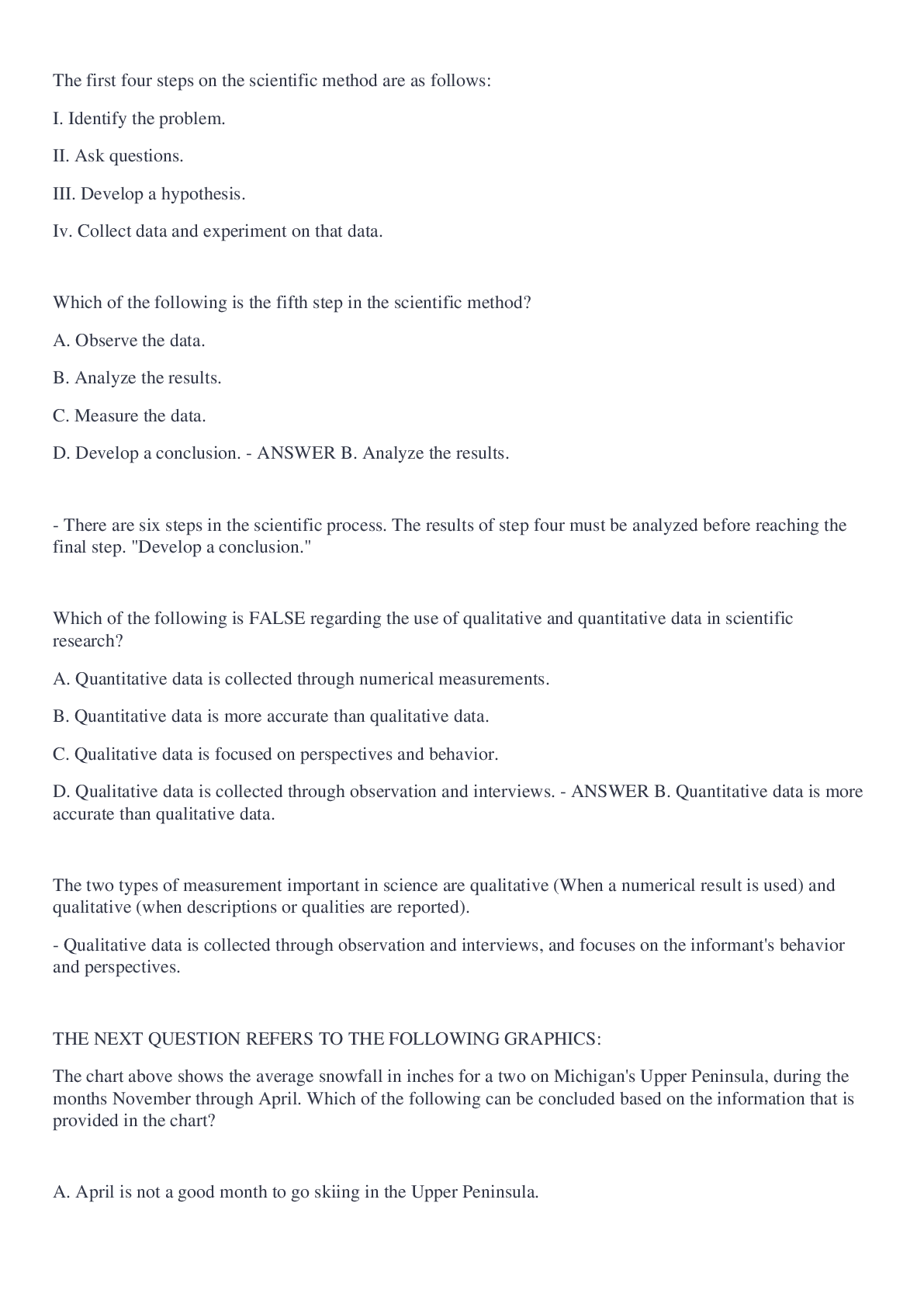
Reviews( 0 )
Recommended For You
Health Care> EXAM > PHTLS Pre & Post Test/75 Questions And Answers/2022 With Complete Solution (Graded A+) (All)
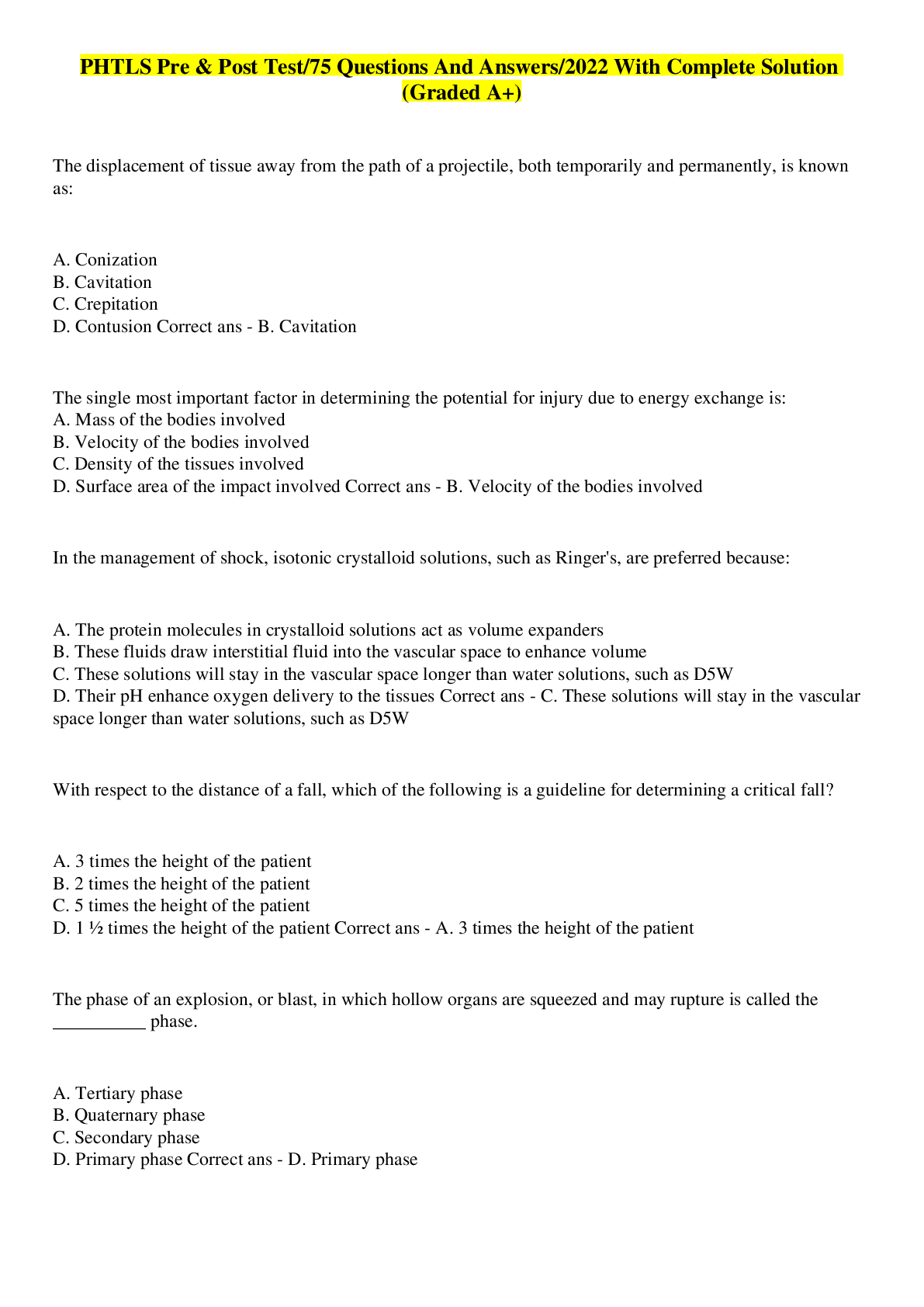
PHTLS Pre & Post Test/75 Questions And Answers/2022 With Complete Solution (Graded A+)
PHTLS Pre & Post Test/75 Questions And Answers/2022 With Complete Solution (Graded A+)
By Filbert , Uploaded: Dec 04, 2022
$9
Health Care> EXAM > NYS EMT-B State Exam Written Study Guide 2022 with COMPLETE SOLUTION (All)
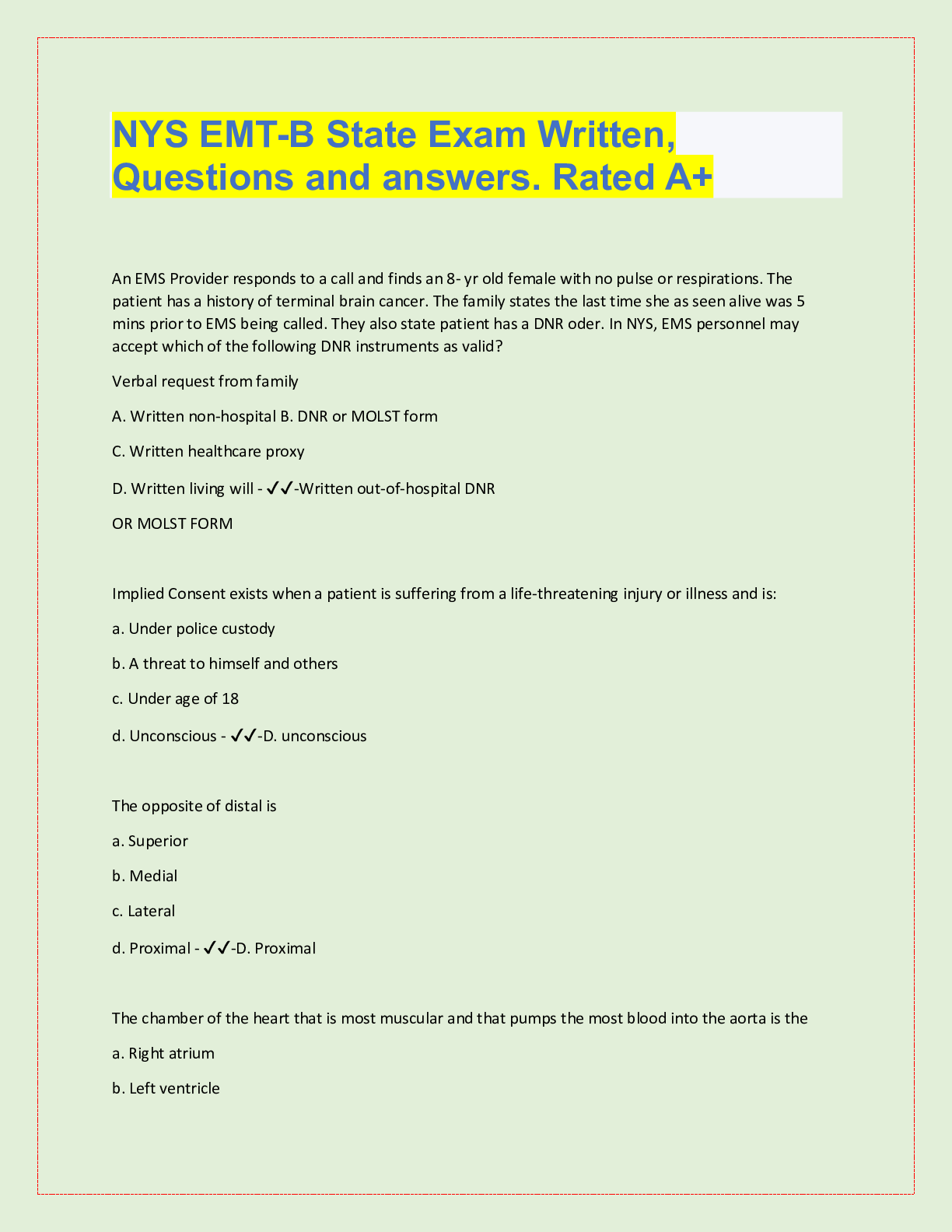
NYS EMT-B State Exam Written Study Guide 2022 with COMPLETE SOLUTION
NYS EMT-B State Exam Written Study Guide 2022 with COMPLETE SOLUTIONAn EMS Provider responds to a call and finds an 8- yr old female with no pulse or respirations. The patient has a history of termi...
By A-LEVEL GURU , Uploaded: Sep 28, 2022
$12
Health Care> EXAM > NYS EMT-B State Exam Written Study Guide 2022 with COMPLETE SOLUTION (All)

NYS EMT-B State Exam Written Study Guide 2022 with COMPLETE SOLUTION
NYS EMT-B State Exam Written Study Guide 2022 with COMPLETE SOLUTIONAn EMS Provider responds to a call and finds an 8- yr old female with no pulse or respirations. The patient has a history of termi...
By A-LEVEL GURU , Uploaded: Sep 28, 2022
$12
Education> EXAM > New York Notary Exam Practice Test 2022 with complete solutions (All)

New York Notary Exam Practice Test 2022 with complete solutions
If a notary refused to notarize an affidavit presented for NY notary mobile services, what is the potential maximum jail sentence? One month Three months Six months One year - ANSWER One year T...
By MARKALLAN , Uploaded: Aug 12, 2022
$9
Education> EXAM > New York Notary Exam Practice Test 2022 with complete solutions (All)

New York Notary Exam Practice Test 2022 with complete solutions
If a notary refused to notarize an affidavit presented for NY notary mobile services, what is the potential maximum jail sentence? One month Three months Six months One year - ANSWER One year T...
By Nancylect , Uploaded: Aug 12, 2022
$8
Management> EXAM > TMC Mechanical Ventilation Practice Questions And Answers Latest Update 2022 With Complete Solution. (All)
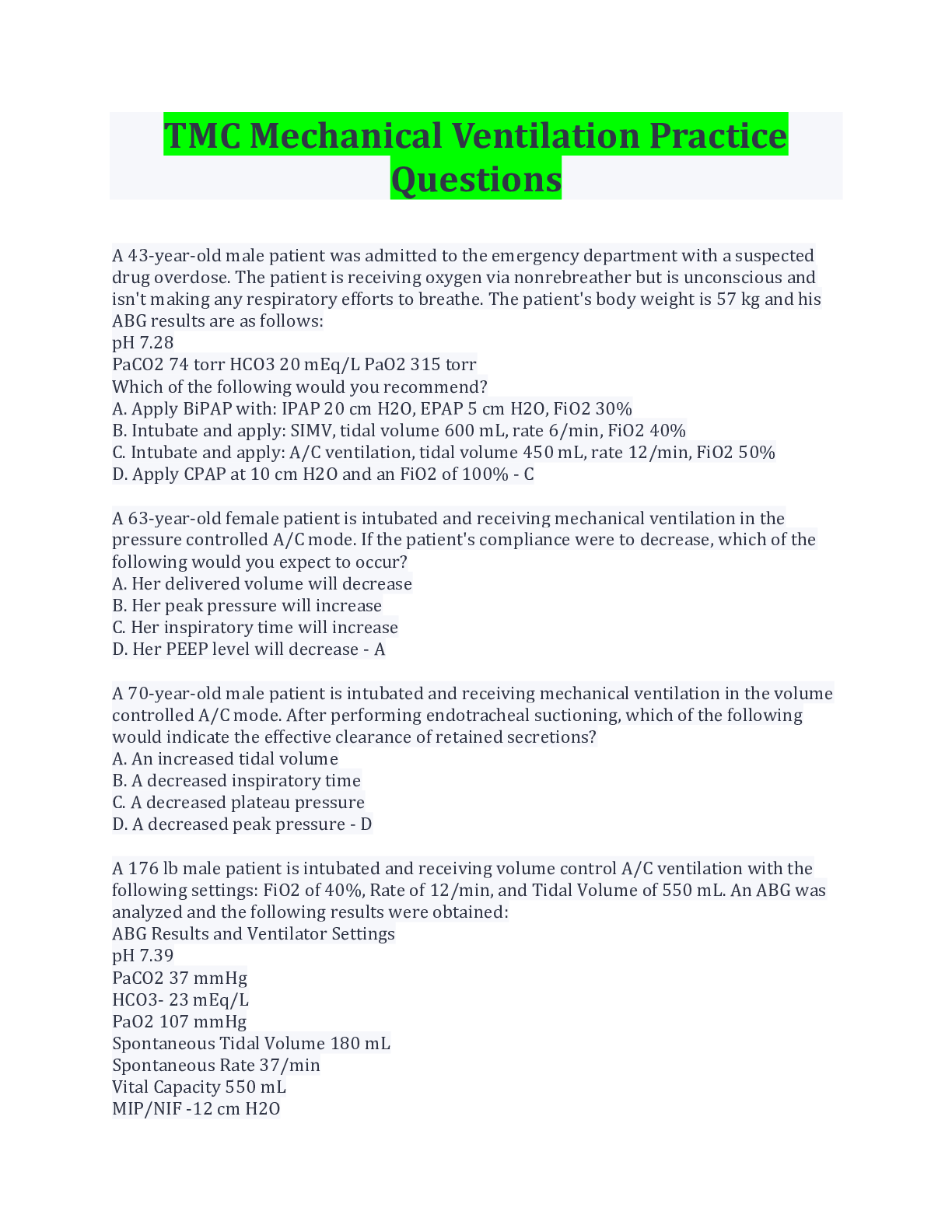
TMC Mechanical Ventilation Practice Questions And Answers Latest Update 2022 With Complete Solution.
TMC Mechanical Ventilation Practice Questions And Answers Latest Update 2022 With Complete Solution.
By Axeldee , Uploaded: Aug 08, 2022
$13
Health Care> EXAM > CPR EXAM 2022 with complete solutions (All)
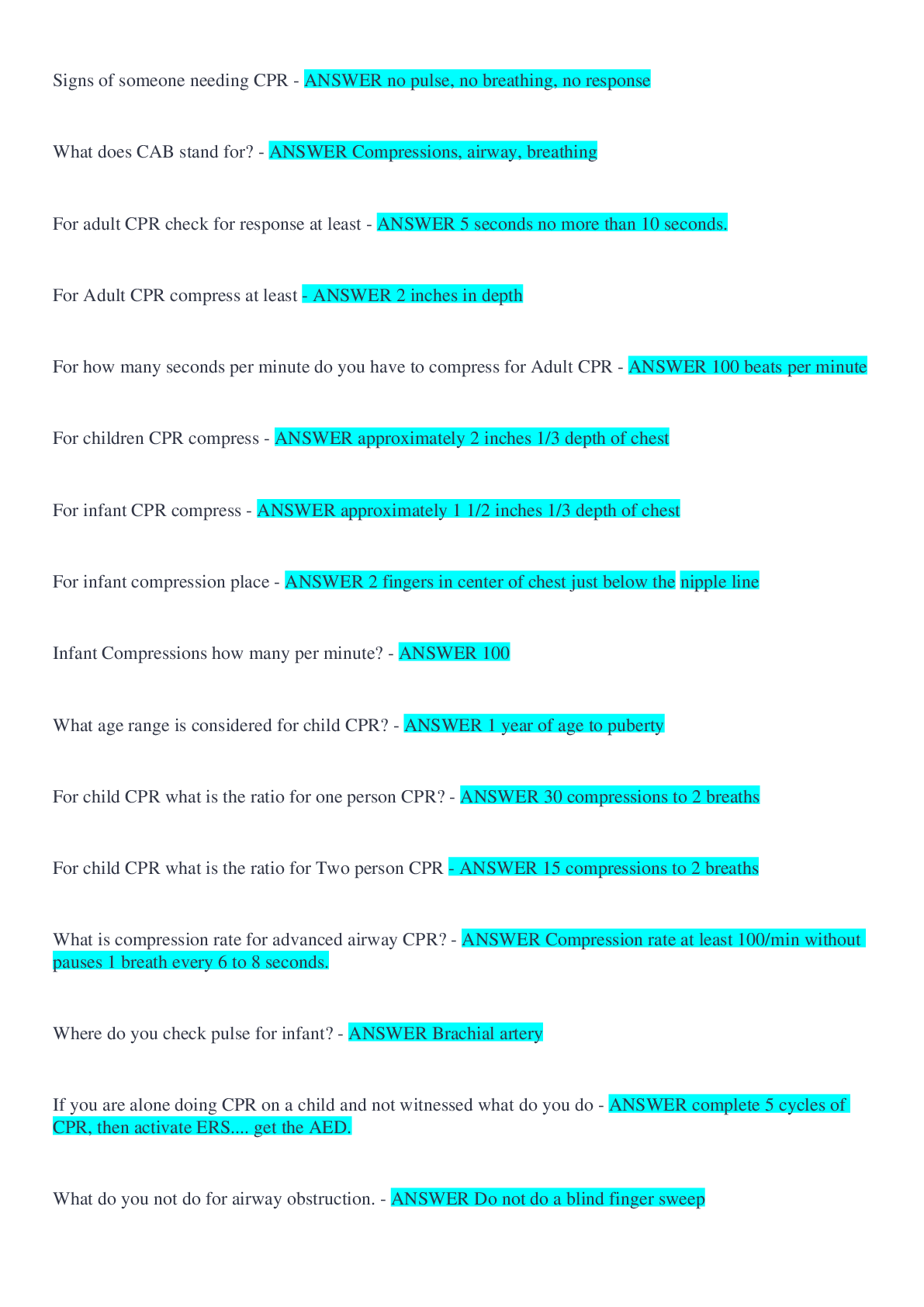
CPR EXAM 2022 with complete solutions
Signs of someone needing CPR - ANSWER no pulse, no breathing, no response What does CAB stand for? - ANSWER Compressions, airway, breathing For adult CPR check for response at least - ANSWER 5 s...
By Nancylect , Uploaded: Aug 08, 2022
$8
Health Care> EXAM > CPR EXAM 2022 with complete solutions (All)

CPR EXAM 2022 with complete solutions
Signs of someone needing CPR - ANSWER no pulse, no breathing, no response What does CAB stand for? - ANSWER Compressions, airway, breathing For adult CPR check for response at least - ANSWER 5 s...
By MARKALLAN , Uploaded: Aug 08, 2022
$7
*NURSING> EXAM > NP230 Mental Health Exam 2022 with complete solutions (All)
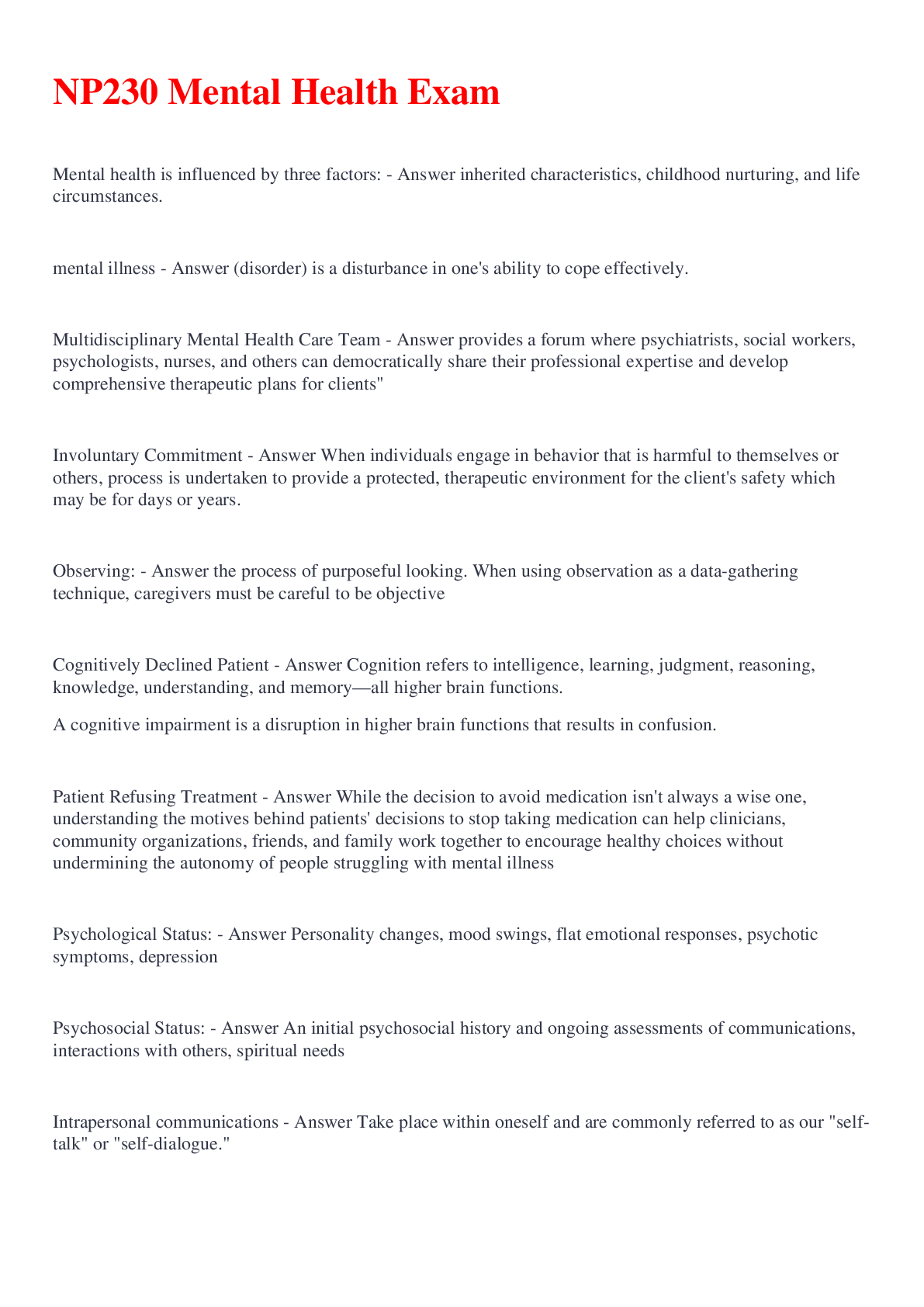
NP230 Mental Health Exam 2022 with complete solutions
Mental health is influenced by three factors: inherited characteristics, childhood nurturing, and life circumstances. mental illness (disorder) is a disturbance in one's ability to cope effecti...
By EVALEEN , Uploaded: Aug 07, 2022
$10
Management> EXAM > CCM EXAM PREP 2022 with complete solutions (All)
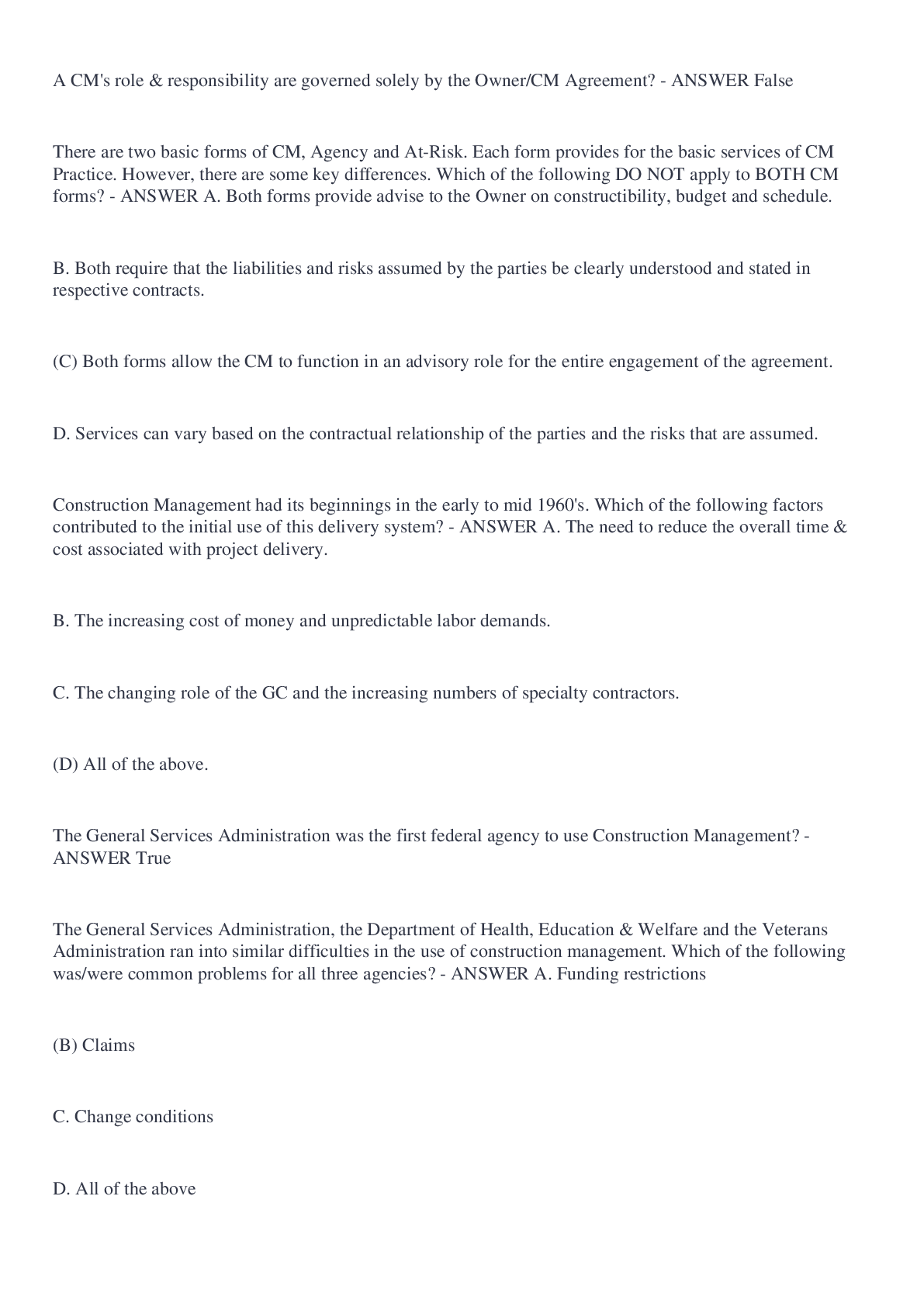
CCM EXAM PREP 2022 with complete solutions
A CM's role & responsibility are governed solely by the Owner/CM Agreement? - ANSWER False There are two basic forms of CM, Agency and At-Risk. Each form provides for the basic services of CM Pract...
By MARKALLAN , Uploaded: Aug 06, 2022
$10
Document information
Connected school, study & course
About the document
Uploaded On
Jul 07, 2022
Number of pages
52
Written in
Additional information
This document has been written for:
Uploaded
Jul 07, 2022
Downloads
0
Views
36






